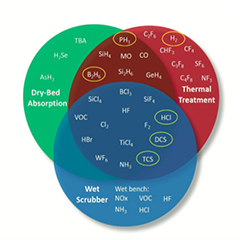The way to the optimal subfab process byproduct gas abatement system: accurately tune to the desired application to ensure the lowest total cost of ownership (TCO). Processes with many safety concerns, such as silicon epitaxy, require looking across many possible technologies. Increasingly complex production processes in the industrial sector lead to rising expectations to the performance of exhaust gas abatement systems: ideally, they will not only comply with local regulations but also feature a comparably low total cost of ownership.
These benefits may be achieved by precisely tuning the technology implemented to the respective application. A good example is the silicon epitaxy process: toxic, corrosive and combustible exhaust gases are used, requiring various gas abatement technologies such as thermal treatment, wet scrubbing with caustic (high pH) media or dry bed absorption. With such demanding processes involving many chemicals, effective abatement and cost efficiency can only be achieved by understanding all objective hazards of the application. Gas abatement experts must be involved who are thoroughly familiar with all potential abatement options and are therefore able to provide unbiased consultation.
By using industry experts rather than choosing technologies arbitrarily, the environment can be protected while minimizing TCO.
According to a WHO study, more than 90 percent of the global population is exposed to polluted air, and around 7 million die each year from the consequences of pollution. In view of these figures, many industrial companies consider the waste gas remediation a costly but noble enterprise. However, there is potential for improving the energy efficiency of entire production processes – for example, if heat from exhaust gas combustion could be reused by recycling it somewhere else in the fab. The first step towards this goal is the use of efficient exhaust gas abatement systems. Modern semiconductor manufacturing processes use an ever expanding range of chemicals, requiring a high degree of flexibility and technological combinations to meet the added challenges. This as a rule leads to special solutions utilizing different gas abatement technologies as required: in the semiconductor and photovoltaic industries multiple abatement technologies are common in a fab, such as thermal treatment (combustion), wet scrubbing and dry bed adsorption.















